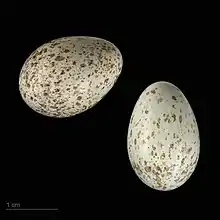Dunn's lark
Dunn's lark (Eremalauda dunni) is a small passerine bird of the lark family. It is a desert bird which is found across parts of the Sahara from Mauritania to central Sudan.
| Dunn's lark | |
|---|---|
 | |
| Scientific classification | |
| Domain: | Eukaryota |
| Kingdom: | Animalia |
| Phylum: | Chordata |
| Clade: | Dinosauria |
| Class: | Aves |
| Order: | Passeriformes |
| Family: | Alaudidae |
| Genus: | Eremalauda |
| Species: | E. dunni |
| Binomial name | |
| Eremalauda dunni (Shelley, 1904) | |
| Synonyms | |
| |

Taxonomy and systematics
Dunn's lark was originally described as belonging to the genus Calendula and has also been classified by some authorities as belonging to the genus Ammomanes.
Stark's lark was formerly also classified in the genus Eremalauda; it has since been moved to Spizocorys, leaving Dunn's lark as the only species in the genus Eremalauda.
The Arabian lark (E. eremodites) of the Arabian Peninsula was formerly considered conspecific, but was classified as a distinct species by the Handbook of the Birds of the World Alive and by Birdlife International, and later by the International Ornithological Congress.[2][3]
Description
Dunn's lark is a stocky bird with a large head and broad wings. It is 14 to 15 cm long with a wingspan of 25 to 30 cm.[4] The upperparts are pale sandy-brown with darker streaks. The underparts are whitish with some dark streaks on the breast. There is a pale stripe over the eye and a pale ring around it. Birds have dark moustachial and malar stripes and a dark mark under the eye. The short, broad tail is black below while the upperside is black with rusty-brown central feathers and pale outer feathers. The bill is large, heavy and pale pinkish or yellowish in colour. After moulting, the birds become gradually duller and the dark markings fainter as the plumage becomes more worn.[5]
The song is a scratchy warbling with short whistling phrases. Males sing either from the ground or in flight, hovering 30 metres or more above the ground.[4]
Distribution and habitat
In Africa, the species has a scattered range from Mauritania through Mali, Niger and Chad to Sudan.[6]
Dunn's larks are found in flat, arid areas with light vegetation such as grass and scattered bushes.[5]
Behaviour and ecology
References
- BirdLife International (2016). "Eremalauda dunni". IUCN Red List of Threatened Species. 2016: e.T103765809A94529651. doi:10.2305/IUCN.UK.2016-3.RLTS.T103765809A94529651.en. Retrieved 12 November 2021.
- del Hoyo, J.; Collar, N. (2017). "Arabian Lark (Eremalauda eremodites)". Handbook of the Birds of the World Alive. Barcelona: Lynx Edicions. Retrieved 19 August 2017.
- BirdLife International (2017). "BirdLife International Checklist Version 9.1". www.birdlife.org. Archived from the original (xlsx) on 18 July 2021. Retrieved 19 August 2017.
- Snow, D. W. & Perrins, C. M. (1998) Birds of the Western Palearctic: Concise Edition, Vol. 2, Oxford University Press.
- Harris, Alan, Shirihai, Hadoram & Christie, David (1996) The Macmillan Birder's Guide to European and Middle Eastern Birds, Macmillan, London.
- Sinclair, Ian & Ryan, Peter (2003) Birds of Africa south of the Sahara, Struik, Cape Town.
